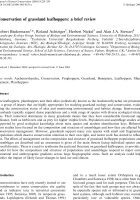Conservation of grassland leafhoppers: an introductory review.
Biedermann R., Achtziger R., Nickel H., Stewart A.J.A. 2005. Journal of Insect Conservation 9(4): 229-243.

Abstract
The leafhoppers, planthoppers and their allies (collectively known as the Auchenorrhyncha) are presented as a group of insects that are highly appropriate for studying grassland ecology and conservation, evaluating the conservation status of sites and monitoring environmental and habitat change. Semi-natural grasslands typically support dense populations and a wide range of species with diverse ecological strategies. Their numerical dominance in many grasslands means that they have considerable functional significance, both as herbivores and as prey for higher trophic levels. Population and assemblage studies are supported by good ecological knowledge about most species and modern identification keys. Hitherto, most studies have focused on the composition and structure of assemblages and how they are affected by conservation management. However, grasslands support many rare species with small and fragmented populations which deserve conservation attention in their own right, and recent work has started to reflect this. The effects of management on the composition and structure of grassland leafhopper populations and assemblages are described and an assessment is given of the main threats facing individual species and overall diversity. There is a need to synthesise the scattered literature on grassland leafhoppers, to provide a model for how the composition and structure of populations and assemblages respond to major environmental and anthropogenic gradients across large biogeographic areas. Such an analysis could help
predict the impact of likely future changes in land use and climate.
Download
Conservation of grassland leafhoppers: an introductory review.


